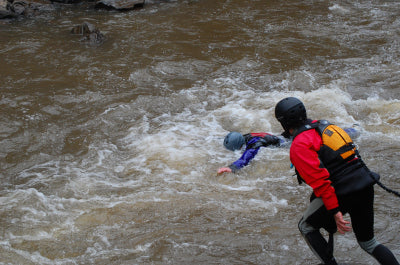The Downstream Edge river rescue class was a huge success last weekend! We had a total of 16 people and 3 coaches, Tommy Hilleke, Evan Stafford, and myself. Evan taught the Level 2 group, I taught the Level 3, and Tommy took on the Rafting crew supplied with the official Team America raft. Overall it was a fantastic class. We saw immense improvement from all of our students on their rescue techniques, river running strategies, group organization, and response times. Everyone got to learn and practice using and releasing their rescue PFD’s, which is an important thing to practice.
A big part of the Level 2 class is getting comfortable swimming in whitewater. We practice a lot of swimming drills. It’s important not only to be able to self rescue when swimming, but also be able to swim out to rescue a person. We teach that when there is a person in danger, a human hand is needed whenever possible. Just using ropes doesn’t always cut it. Also accessing people in your kayak is often a great idea, however, sometimes it’s just easier and more reliable to swim to them.

The most common rescue situation in Kayaking is the typical swimmer and yard sale of gear. It's also one of the most dangerous rescue situations.
We’ve all been on the river when someone swims. It usually works out fine, but I feel that this is one of the most dangerous situations to be in. You have a person, their gear, and a bunch of kayakers all moving downriver…fast. Group organization and communication become difficult, and typically people don’t communicate. It’s because of this that communication is so important. Too many times have I seen people just chase after an empty kayak down river, by themselves. It doesn’t take a genius to see how that could result in bad things happening. We work a lot on dynamic rescue situations like this in our classes. We want everyone to be prepared for these situations.

Live bait access from upstream. this drill was considering a pinned kayaker on the rock. Live bait comes in from upstream, grabs the person, and the shore team hauls them out.
The first step in rescuing a person is getting to them. There are many ways to access spots in the river…Kayaking, rafting, swimming, zip lines, etc. We prefer to keep things simple and safe. A single line tethered swimmer is often a very effective way to access. It’s important for the rescuer to start swimming far enough upstream to get to their destination. The position of the man on shore holding the line is also important. They must be downstream enough to be able to bring the swimmer and the victim in without fighting the current. Sometimes one rope isn’t enough. A v-lower can be used to have more control over the placement of the rescue swimmer. Two lines from opposite sides of the river allow the rescuers to be more accurate.
The Rafting group had an exciting class as well. The Team America raft provided some excellent scenarios. The group actually got to free a wrapped raft. That is a difficult feat sometimes. Rafts are usually much harder to rescue than a pinned kayak. Z-drags are much more necessary with raft rescue than kayak rescue.
Thanks to everyone that was a part of this class. It really was a great experience for everyone. We all learned a lot, and we were super impressed with the motivation of the students to learn.












